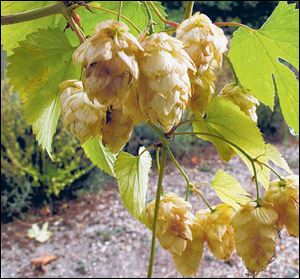
Beer garden: crafting a creative brew from plants you grow
7/9/2014
Hops are easy to grow and greatly enhance a beerâs flavor when picked fresh.
You don’t need a garden to succeed as a home brewer, but growing your own ingredients is a flavorful step up.
Much of the creativity involved in crafting a custom-made beer starts with the plants you select.
“The modern palate pretty much demands some hops in beer, but beyond that, there’s a lot of choices available,” says Dennis Fisher, an organic farmer from Winterport, Maine.
Fisher, who with his brother Joe wrote a popular reference book for beginners, “The Homebrewer’s Garden” (Storey Publishing, 1998), says one of the most satisfying aspects of home brewing is producing some or all of your own ingredients from scratch. “Scratch brewing,” the brothers wrote, “refers to the cultivation, preparation and use of hops, barley, malts and other non-barley grains, and adjuncts ranging from fruits to herbs to vegetables.”
Growing your own ingredients ensures that the products are as organic, fresh and unique as possible. Homegrown also is cheaper than store-bought, the Fishers say.
The four basic ingredients needed for brewing are malt (malting provides the fermented sugar that yeast feeds on to produce alcohol), hops (reduces spoilage and balances the sugar’s sweetness with a bitter flavor), brewer’s yeast and water (about 90 percent of beer’s content).
“Hops are a particularly good (garden) choice because they thrive almost anywhere,” says Dennis Fisher. “They are also a great addition to a landscape — big, attractive columns of greenery.”
If the water from your tap tastes good, then it also should taste good in the beer you make, Fisher says. “But if it’s chlorinated, then you need to let it stand overnight to allow the chemicals to outgas before brewing with it.”
Adjuncts, in homebrew speak, are plants used to replace or complement hops to give beers distinctive flavors, odors and colors.
“Just about any flower you can eat can be made into a beer,” says Rebecca Kneen, an organic farmer and writer from Sorrento, British Columbia, who wrote about backyard brewing in the new “Groundbreaking Food Gardens,” By Niki Jabbour (Storey Publishing).
“It’s useful to experiment with them all though to determine how much should be used and when they should be added,” Kneen says.
Some common and not so common home brewer’s garden adjuncts include:
— Herbs: (Bittering) Sage, horehound, gentian, yarrow. (Flavoring) Juniper, rosemary, ginger, oregano, mint, thyme. (Aromatic) Lavender, lemon balm, chamomile.
— Flowers: Nasturtiums, wild roses, scented geranium leaves, daylilies and marigolds.
— Vegetables and fruits: Rhubarb, blackberries and elderberries, pumpkin, chili peppers, sorghum, apples. “We like to add spruce tips to some beers,” Fisher says. “It’s more of a wild-gathered than home-grown adjunct that in Colonial times was a hops substitute.”
For even “greener” beer, recycle the brewing ingredients and their byproducts, Kneen says. “You can compost them, feed them to pigs and sheep, put some into your chicken feed,” she says. “We use them heavily as mulch ... The gray water (relatively clean wastewater) is used for irrigation on our pastures. That’s the bulk of what comes out of our brewery.”